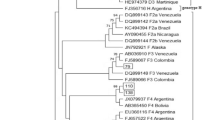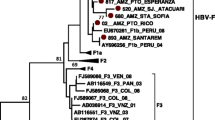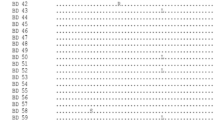Summary
Four cases of type 2 hepatitis B virus (HBV-2) infection were demonstrated in the Gizan area of Saudi Arabia during the hepatitis B marker ELISA screening of the 152 native pregnant females, 42 cases of primary hepatocellular carcinoma, 19 cases with an epithelial but non-hepatic malignancy, 16 with a non-epithelial and non-hepatic malignancy and eight with chronic hepatitis. HBV-2 infection diagnosis was based on HBsAg positivity without anti-HBc, anti-HBs and HBeAg in one pregnant female and one patient each with a primary hepatocellular carcinoma, lymphocytic lymphoma and metastatic adenocarcinoma. During neutralisation of HBsAg ELISA reactivity, the respective reduction in absorbance values in sera from the pregnant female and the patient with primary hepatocellular carcinoma were 21% and 76% respectively. HBV-2 specific gene probes would be needed to define its role in pathogenesis of malignant neoplasms and chronic hepatitis. Incorporation of pre-S2 sequences in future hepatitis B vaccines is likely to protect against both, HBV-2 and conventional hepatitis B (HBV-1) exposures.
Zusammenfassung
Screeninguntersuchungen auf Hepatitis B Marker mittels ELISA bei 152 schwangeren Eingeborenen der Region Gizan, Saudi-Arabien, 42 Patienten mit primärem Leberzellkarzinom, 19 Kranken mit epithelialen und 16 mit nicht epithelialen malignen Erkrankungen, die nicht in der Leber lokalisiert waren sowie acht Patienten mit chronischer Hepatitis deckten vier Fälle von Hepatitis B Virus Typ 2 (HBV-2)-Infektionen auf. Die Diagnose einer HBV-2-Infektion bei einer Schwangeren, und je einem Patienten mit primärem Leberzellkarzinom, lymphozytärem Lymphom und metastasierendem Adenokarzinom wurde gesichert durch den Nachweis von HBsAg in Abwesenheit von anti-HBc, anti-HBs und HBeAg. Neutralisation der HBsAg ELISA Aktivität verursachte eine Verminderung der Absorptionswerte, die sich im Serum der Schwangeren auf 21% und im Serum des Patienten mit primärem Leberzellkarzinom auf 76% belief. Man benötigt spezifische Genproben, um die Bedeutung von HBV-2 für die Entstehung maligner Tumoren und der chronischen Hepatitis zu klären. Es ist anzunehmen, daß die Inkorporation von prä-S2-Sequenzen in zukünftige Hepatitis B Vakzinen sowohl gegen HBV-2 wie konventionelle Hepatitis B (HBV-1) Infektionen schützen wird.
Similar content being viewed by others
References
Coursaget, P., Yvonnet, B., Bourdil, C. HBsAg positivity in man not due to hepatitis B virus. Lancet ii (1987) 1354–1358.
Redeker, AG, Govindarajan, S. Possible case of HBV-2 infection. Lancet i (1988) 656.
Budkowska, A., Dubreuil, P., Ouatarra, A., Pillot, J. Anti-pre S2 as only serum marker: possible relation to HBV-2 infection. Lancet i (1988) 656.
Wu, J.-S., Ko, Y.-C., Liu, W.-T. Hepatitis B virus type 2. Lancet i (1988) 990.
Arya, S. C., Ashraf, S. J., Parande, C. M. Hepatitis B virus in Gizan, Saudi Arabia. J. of Med. Virol. 17 (1985) 267–274.
Arya, S. C., Parande, C. M., Ashraf, S. J. False-positive ELISA reactivity to hepatitis B surface antigen (HBsAg). Infection 14 (1986) 152.
Abbott Laboratories Diagnostics Division: Abbott HBe (rDNA) EIA. Enzyme immunoassay for qualitative or semi-quantitative detection of hepatitis Be antigen and/or antibody to hepatitis e antigen. 1986, p. 17.
Abbott Laboratories Diagnostic Division: Antibody to hepatitis B surface antigen (human). HBsAg confirmatory assay. 1987, p. 13.
Budkowska, A., Dubreuil, P., Ouattona, A., Pillot, J. Hepatitis B virus type 2. Lancet i (1988) 990.
Barbara, J. A., Tedder, R. S., Briggs, M. Anti-HBc testing alone not a reliable blood donor screen. Lancet i (1984) 346.
Coutoucé, A. M., Drouet, J., Le Marrec, N., Drouet, A., Soulier, J. P. Blood donors positive for HBsAg and negative for anti-HBc antibody. Vox Sang. 49 (1985) 26–33.
Kaneko, S., Feinstone, S. M., Miller, R. H. Rapid and sensitive method for the detection of serum hepatitis B virus DNA using the polymerase chain reaction technique. J. Clin. Microbiol. 27 (1989) 1930.
Coursaget, P., Yvonnet, P., Anthonioz, P., Chotard, J., Bourdil, C., Adamowicz, P. Immunogenicity of a hepatitis B vaccine obtained by genetic recombination and containing S and pre-S2 gene products. Presse Méd. 17 (1988) 1150–1151.
Author information
Authors and Affiliations
Rights and permissions
About this article
Cite this article
Arya, S.C., Pathak, V.P. & Ashraf, S.J. Type 2 hepatitis B virus (HBV-2) in carriers and patients with malignancy in Saudi Arabia. Infection 18, 215–218 (1990). https://doi.org/10.1007/BF01643389
Received:
Accepted:
Issue Date:
DOI: https://doi.org/10.1007/BF01643389




